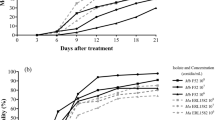Abstract
Bacillus thuringiensis is a highly specific entomopathogenic microorganism. Although defined as having properties which work against insects, its role in the control of tick populations is still insufficiently known. In our bioassay, four environmental strains of B. thuringiensis, along with one commercially available product (Vectobac), have been used against ticks. Vectobac turned out to be ineffective in the biocontrol of ticks; however, two of environmental B. thuringiensis strains proved to be efficient against both Ixodes ricinus and Dermacentor reticulatus. In those cases, the mortality rate for ticks was assessed as being up to 80%, and LC50 ranged between 9.1 × 106 and 1.3 × 1015 (cfu/ml). Dermacentor reticulatus males were the most sensitive to bacteria. The similarity between the most and least efficient B. thuringiensis strains in enzymatic profiles—including lipases, phosphatases, proteases, and chitinases—may indicate a limited role of detected enzymes in the pathogenicity profile of bacterial strains against ticks.
Similar content being viewed by others
References
Carpi G, Cagnacci F, Wittekindt NE, Zhao F, Qi J, Tomsho LP, Drautz DI, Rizzoli A, Schuster SC (2011) Metagenomic profile of the bacterial communities associated with Ixodes ricinus ticks. PLoS One 6(10):e25604. https://doi.org/10.1371/journal.pone.0025604
Doroszkiewicz W, Lonc E (1999) Biodiversity of Bacillus thuringiensis strains in the phylloplane and soil of Lower Silesia Region (Poland). Acta Microbiol Pol 48:355–361
Fernández-Ruvalcaba M, Romo-Martínez GA, Hernández-Velázquez V, Bravo de Parra A, Pérez De La Rosa D (2010) Evaluation of Bacillus thuringiensis pathogenicity for a strain of the tick, Rhipicephalus microplus, resistant to chemical pesticides. J Insect Sci 10:1–6
Finney DJ (1952) Probit analysis (2nd Ed). J Inst Actuar 78(3):388–390
Frankenhuyzen K (1993) The challenge of Bacillus thuringiensis. In: Entwistle PF, Cory JS, Bailey MJ, Higgs S (eds) Bacillus thuringiensis an environmental biopesticide: theory and practice. John Wiley & Sons, Chichester, pp 1–35
Guz K, Kucińska J, Lonc E, Doroszkiewicz W (2005) Differentiated pattern of protein composition of crystalline inclusions of newly isolated Bacillus thuringiensis strains from Silesia in Poland. Pol J Microbiol 54(4):263–269
Habeeb SM, El-Hag HAA (2008) Ultrastructural changes in hemocyte cells of hard tick (Hyalomma dromedarii: Ixodidae): a model of Bacillus thuringiensis var. thuringiensis H14 d-endotoxin mode of action. Am Eurasian J Agric Environ Sci 3(6):829–836
Hassanain MA, Garhy MFEL, Abdel-Ghaffar FA, El-Sharaby A, Megeed KNA (1997) Biological control studies of soft and hard ticks in Egypt. Parasitol Res 83(3):209–213
Klubal R, Kopecky J, Nesvorna M, Sparagano OAE, Thomayerova J, Hubert J (2016) Prevalence of pathogenic bacteria in Ixodes ricinus ticks in Central Bohemia. Exp Appl Acarol 68:127–137. https://doi.org/10.1007/s10493-015-9988-y
Król N, Obiegala A, Pfeffer M, Kiewra D (2016) Detection of selected pathogens in ticks collected from cats and dogs in the Wrocław Agglomeration, South-West Poland. Parasit Vectors 9(1):351
Lonc E, Lecadet MM, Lachowicz TM, Panek E (1997) Description of Bacillus thuringiensis wratislaviensis (H-47), a new serotype originating from Wroclaw (Poland), and other B. thuringiensis soil isolates from the same area. Lett Appl Microbiol 24(6):467–473
Lonc E, Kucińska J, Rydzanicz K (2001a) Toxicity of isolates of Bacillus thuringiensis from Wroclaw against larvae of Aedes aegypti. Ann Parasitol 47(3):297–303
Lonc E, Doroszkiewicz W, Klowden MJ, Rydzanicz K, Galgan A (2001b) Entomopathogenic activities of environmental isolates of Bacillus thuringiensis against dipteran larvae. J Vector Ecol 26(1):15–20
Lonc E, Kucińska J, Rydzanicz K (2003) Comparative delta-endotoxins of Bacillus thuringiensis against mosquito vectors (Aedes aegypti and Culex pipiens). Acta Microbiol Pol 52(3):293–300
Longe OO (2016) Biological control: a veritable natural pest management strategy. Int J Agr Environ Res 02(01):57–74
Nowak-Chmura M (2013) Fauna kleszczy (Ixodida) Europy Środkowej. Wyd Naukowe Uniwersytetu Przyrodniczego, Kraków
Parola P, Raoult D (2001) Tick-borne bacterial diseases emerging in Europe. Clin Microbiol Infect 7(2):80–83
Raymond B, Johnston PR, Nielsen-LeRoux C, Lereclus D, Crickmore N (2010) Bacillus thuringiensis: an impotent pathogen? Trends Microbiol 18(5):189–194
Rudolf I, Mendel J, Šikutová S, Švec P, Masaříková J, Nováková D, Buňková L, Sedláček I, Hubálek Z (2009) 16S rRNA gene-based identification of cultured bacterial Flora from host-seeking Ixodes ricinus, Dermacentor reticulatus and Haemaphysalis concinna ticks, vectors of vertebrate pathogens. Folia Microbiol 54(5):419–428
Sanahuja G, Banakar R, Twyman RM, Capell T, Christou P (2011) Bacillus thuringiensis: a century of research, development and commercial applications. Plant Biotechnol J 9(3):283–300
Siuda K (1993) Kleszcze (Acari: Ixodida) Polski. II. Systematyka i rozmieszczenie. Monografie Parazytologiczne. Polish Parasitological Society, Warsaw
Thiery I, Frachon E (1997) Bacteria: identification, isolation, culture and preservation of entomopathogenic bacteria. In: Lacey LA (ed) Manual of techniques in insect parasitology, Cap. III-1, biological techniques series. Academic Press, London
Zając V, Wójcik-Fatla A, Sawczyn A, Cisak E, Sroka J, Kloc A, Zając Z, Buczek A, Dutkiewicz J, Bartosik K (2017) Prevalence of infections and co-infections with 6 pathogens in Dermacentor reticulatus ticks collected in eastern Poland. Ann Agric Environ Med 24(1):26–32. https://doi.org/10.5604/12321966.1233893
Zhioua E, Heyer K, Browning M, Ginsberg HS, LeBrun RA (1999) Pathogenicity of Bacillus thuringiensis variety kurstaki to Ixodes scapularis (Acari: Ixodidae). J Med Entomol 36:900–902
Acknowledgements
We would like to dedicate this article to our mentor, Professor Elżbieta Lonc, who passed away in March 2017. Without her great experience and knowledge, the bioassays of Bacillus thuringiensis would never have been carried out. We would like to express gratitude for the advantage of working with such a person, who always supported us and provided new ideas for solving problems.
Funding
The chitinase assay was financed by the University of Wroclaw (grant number 0420/2308/17).
Author information
Authors and Affiliations
Corresponding author
Ethics declarations
Conflict of interest
The authors declare that they have no conflict of interest.
Additional information
Section Editor: Neil Bruce Chilton
Rights and permissions
About this article
Cite this article
Szczepańska, A., Kiewra, D. & Guz-Regner, K. Sensitivity of Ixodes ricinus (L., 1758) and Dermacentor reticulatus (Fabr., 1794) ticks to Bacillus thuringiensis isolates: preliminary study. Parasitol Res 117, 3897–3902 (2018). https://doi.org/10.1007/s00436-018-6096-z
Received:
Accepted:
Published:
Issue Date:
DOI: https://doi.org/10.1007/s00436-018-6096-z




